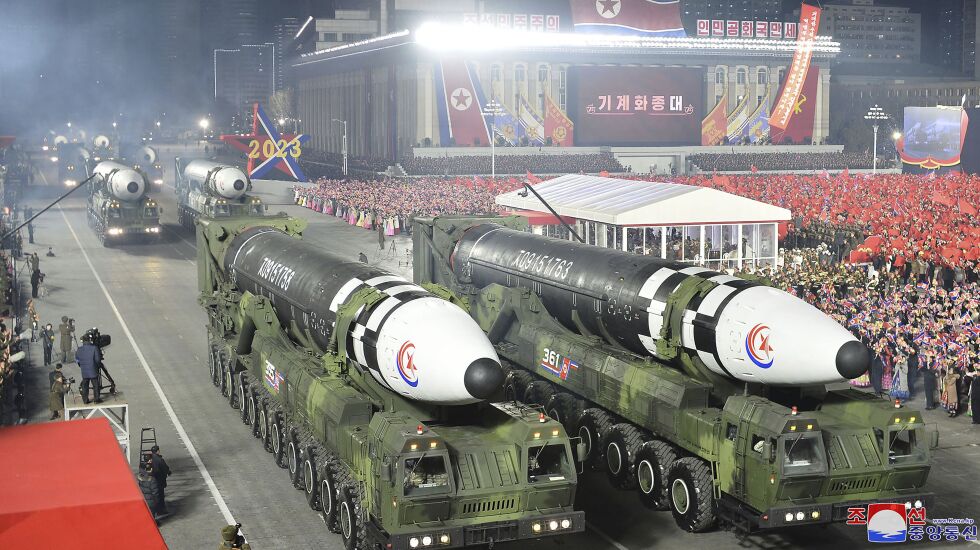
SEOUL, South Korea — North Korea’s latest missile launches are a demonstration of the country’s avowed ability to use nuclear force against South Korea and the mainland United States.
North Korea says its nuclear forces are capable of destroying its rivals. But many foreign experts say the country’s claims are propaganda and suggest it isn’t yet capable of hitting the United States or its allies with a nuclear weapon.
Here’s a look at its capabilities.
ICBMs
North Korea has demonstrated it has missiles that could reach deep into the continental United States — but it’s not clear whether they can survive re-entering the Earth’s atmosphere on arrival.
North Korea said it launched a Hwasong-15 intercontinental ballistic missile last weekend to verify the weapon’s reliability. It’s one of three kinds of ICBMs the country has developed, along with the Hwasong-14 and Hwasong-17. North Korea has portrayed all as nuclear-capable.
Launched almost straight up to avoid the territories of neighbors, the weapon reached a maximum altitude of about 3,585 miles and flew 615 miles, according to North Korean state media. The reported flight details suggest the missile could travel 8,080 miles or beyond if launched on a normal trajectory.
“These days, North Korea has been disclosing information about its launches in a very detailed manner to try to let others believe what they’ve done is genuine,” analyst Shin Jong-woo at South Korea’s Defense and Security Forum said. “But I think that’s part of their propaganda.”
There are questions about whether North Korea has acquired the technology to shield warheads from the high-temperature, high-stress environment of atmospheric re-entry.
According to a South Korean biennial defense document, it’s not clear whether the missiles can survive re-entry because all of North Korea’s ICBM tests have so far been made on high angles.
North Korean state media said the launch was made “suddenly” after a surprise order from leader Kim Jong Un.
“The Kim regime’s claims of short-notice launches are thus intended to demonstrate not only the development of strategic and tactical nuclear forces but also the operational capability to use them,” said Leif-Eric Easley, a professor at Ewha University in Seoul.
In a military parade earlier this month, North Korea showcased around a dozen ICBMs, an unprecedented number that suggested progress in efforts to mass-produce powerful weapons.
WARHEADS
North Korea likely has dozens of nuclear warheads. But are they small enough to fit on a missile?
It has performed six underground nuclear test explosions to manufacture warheads it can place on missiles. Outside estimates of the number of North Korean nuclear warheads vary widely, ranging from 20 to 60 to up to about 115.
In a 2021 interview with 38 North, a North Korea-focused website, renowned nuclear physicist Siegfried Hecker, who has visited North Korea’s main Yongbyon nuclear complex numerous times, said that “20 to 60 is possible, with the most likely number being 45.”
Some experts say it’s likely North Korea has built miniaturized nuclear warheads to be mounted on missiles. Others say North Korea is years away from producing such warheads.
North Korea described its sixth nuclear test in 2017 as a detonation of a thermonuclear bomb built for ICBMs. Some studies put its estimated explosive yield at 50 to 140 kilotons of TNT. The pair of atomic bombs dropped on Hiroshima and Nagasaki during World War II — killing more than 210,000 people — yielded explosions equivalent to about 15 and 20 kilotons of TNT.
The South Korean defense document said North Korea is estimated to have 154 pounds of weapons-grade plutonium. Some observers say that’s enough for about nine to 18 bombs. The document estimated that North Korea also has “a considerable amount of” highly enriched uranium as well.
The Yongbyon complex has facilities to produce plutonium and highly enriched uranium — the main ingredients to build nuclear weapons.
Plutonium plants generally are large and generate a lot of heat, making them easier to detect. A uranium enrichment plant is more compact and can be easily hidden from satellite cameras.
SHORT-RANGE WEAPONS
Following the collapse of diplomacy with then-President Donald Trump in 2019, Kim sped up development of short-range solid-fuel, nuclear-capable missiles designed to strike key targets in South Korea, including U.S. military bases there.
The so-called “tactical” nuclear weapons include what North Korea calls “super-large” 600-millimeter multiple rocket launchers it tested Monday. South Korea describes the weapon as a short-range missile system.
North Korean state media said its new artillery system can carry nuclear warheads and that four rockets would be enough to wipe out an enemy airfield. The statement drew outside doubts about whether the weapons are indeed nuclear-capable.
“The North Korean claim doesn’t make sense to some extent. ... Why do they need four tactical nuclear weapons to destroy just one airfield?” Shin said. “Also, which country would disclose such attack scenarios via state media?”







